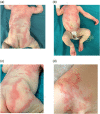Rare and common manifestations of COVID-19 in children
- PMID: 37829273
- PMCID: PMC9088562
- DOI: 10.1002/jvc2.10
Rare and common manifestations of COVID-19 in children
Abstract
Introduction: It has been almost 2 years since the first reports on cutaneous manifestations of COVID-19. Those reported in children are different and include macular, papular, lichenoid, vesicular, urticarial, and vascular morphologies, among others. The prognosis of isolated cutaneous involvement in COVID-19 in children is usually self-limiting but the extreme variety of clinical presentations complicates the clinical approach.
Methods: Numerous reviews have been systematically drafted and edited giving the clinicians a future direction for skin presentations during pandemics.
Results and discussion: Hereby we report the rare and common manifestations of COVID-19 in children and question the recurrence phenomena and age-related distribution of the eruptions.
Keywords: MIS‐C; Sars‐CoV‐2; chilblains; chilblain‐like; children.
© 2022 The Authors. JEADV Clinical Practice published by John Wiley & Sons Ltd on behalf of European Academy of Dermatology and Venereology.
Conflict of interest statement
The authors declare that there are no conflict of interests.
Figures








References
-
- Recalcati S. Cutaneous manifestations in COVID‐19: a first perspective. J Eur Acad Dermatol Venereol. 2020;34:e212–3. - PubMed
Publication types
LinkOut - more resources
Full Text Sources
Miscellaneous
